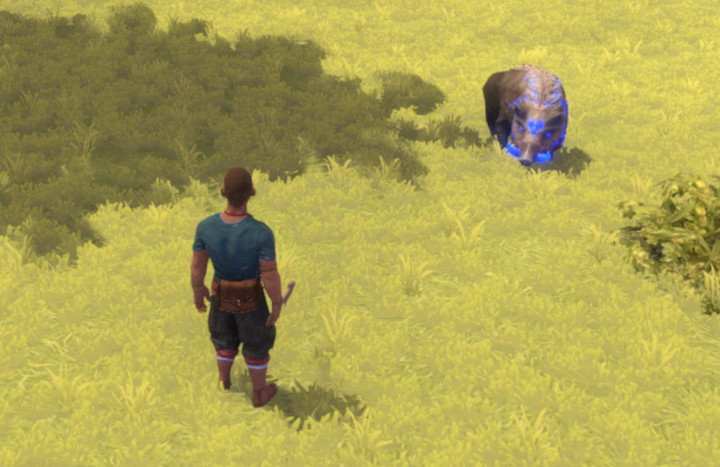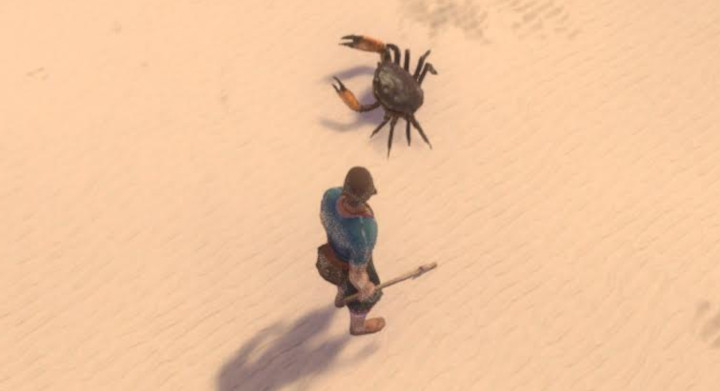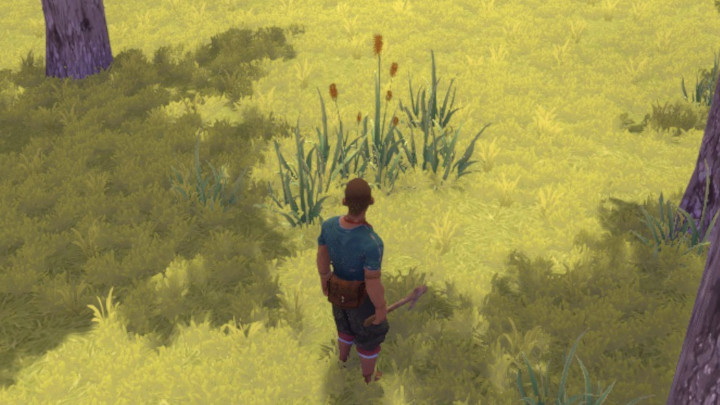
Breakwaters, like any self-respecting crafting survival game, has a number of resources to be harvested throughout its island biomes. Some are pretty apparent in where to find them or how to use them, and the in-game crafting system does a great job letting the player know which items are needed for what recipe.
But sometimes, it isn’t immediately apparent how to find what you are looking for, or even what something might be needed for. And although there are still some unknowns regarding some of the resources in Breakwaters, I thought I would put together a resource compendium to offer as much insight as I can. This can also be a one-stop shop for anyone who wants a resources… well, resource.
So let’s jump in.
Bamboo

Starting on the second island you discover in Breakwaters, you should find plenty of bamboo. Once you whack away and harvest bamboo, this can be used to make water pipes which will allow you to transport water and also increase the efficiency of your crafting stations.
Bamboo Shoots

Bamboo should be pretty recognizable to anyone that is familiar with the plant’s distinctive smooth green shoots between knobby, kneecap-like bumps.
Berries

Berries are your first and easiest source of readily edible food in Breakwaters. It takes a couple dozen to fully top you off, as they only grant + 5 Hunger, but beggars can’t be choosers in those desperate early hours.
Berry Bush

Berry bushes are your one-stop source for berries. Berry bushes, much like the regular bushes (more on those later) also provides sticks, which are a vital crafting resource. But be careful, as rats are also known to inhabit berry bushes, and they don’t take kindly to being thrusted from their bushy homes.
Blue Crystal

Blue crystals are the larger fragments that result from smashing the blue crystal formations that are first discovered on the second island in Breakwaters. You can always spot when a crystal formation is nearby because it produces a stream of water it produces. They can often be found among bamboo croppings, but they’re also found in the base of pine trees. These larger crystals are used in some crafting recipes, but it is their smaller incarnations that are required to refine blue crystals.
Blue Crystal Boar

There’s a blue crystal variant of the boars that, when killed, drops blue shards and boar tusks.
Blue Shards

Blue shards can result naturally from breaking apart blue crystal formations, or they can be created using blue crystals at a refinery station. These shards are needed to craft refined blue crystals, which are used to summon water in Breakwaters.
Boar

Boars are one of the few animals found roaming the various islands. They are passive — despite the aggressiveness of their real-world counterparts — and will not inflict any damage, though they will flee a few meters once attacked. Boars will produce bones and raw meat when you kill them.
Boar Tusks

You can collect boar tusks by killing boars. There doesn’t appear to be an immediate use for the boar tusks, but they are nice little trinkets to look at.
Bone

Bone can be harvested from dead chicken and boars. They can also be found randomly in some of the crates that litter coastlines and, oddly enough, even from the random Water Leaf Plant. Outside of your inventory, they resemble hilariously large rib cages, and, as silly as it may seem, you can even get a number of these from one animal. Once in your inventory, they look like your average cartoon dog bone. Bone is most notably used to create the bottom-tier bone armor.
Bush

Much like the berry bush, the regular bush is a source for sticks and the occasional rat, but they do not provide any berries, hence the berry-less moniker. But sticks are pretty vital in Breakwaters, and not every bush provides them. In fact it’s probably about a third or more that don’t.
Cannon Ball

As far as I can tell, these little beauties are just ammo for cannons and have yet to serve any actual crafting purpose. You can find cannons scattered around on some islands, I usually find them among the camps of stranded pirates or near ancient sites.
Chicken

Chickens don’t mess around in Breakwaters — if you get too close, they will attack. Luckily, they don’t put up much of a fight, and they offer a few valuable resources, namely raw meat, bone, feathers, and sometimes eggs. Their nests usually have one egg as well. The raw meat, once cooked, will offer a better source of food than raw berries.
Chicken Egg

Chicken eggs can be harvested from chicken nests and sometimes collected by killing chickens. The egg itself isn’t edible or able to be cooked, so it must be used with other ingredients to make a proper meal.
Chicken Feather

Chicken feathers can be harvested from chickens, and they’re useful for making arrows.
Coconut

Coconuts will serve as your first most readily available source of water on the opening island. You will get at least three per palm tree you harvest, and although they don’t offer much of a hydration boost, they’re really all you’ve got before you can start filling up water bottles down the road with the likes of the solar still. Coconuts are also needed for other recipes such as armor.
Cooked Meat

Cooked meat is created by, you guessed it, cooking raw meat at either a Fire Pit or a Roasting Pit. It grants +10 to Hunger when consumed. If you want to know more about cooking in Breakwaters, make sure to check out my guide to cooking, hunger, and hydration.
Cooked Mussel

When you cook raw meat, you end up with cooked meat, so what do you think happens when you cook raw mussel? If you answered, “You get cooked mussel,” then you win a prize! Of course, it’s an imaginary prize, but it’s a prize nonetheless. Eating one of these tasty treats restores +5 Hydration.
Crab

These little buggers are found scavenging around shorelines. Crabs are a decent source for raw meat, but they’ll also occasionally provide you with fine sand and crab shells.
Crab Shell

Crab shells can be harvested from crabs. They are needed for crafting items like the crab shell axe (your first axe in the game and an early crafting assignment).
Crate

Crates are found littered around shorelines. They are like nature’s grab bag; you never know what you’re gonna get. In my experience, crates typically have cannonballs, coconuts, bones, or glass bottles. These little boxes can be a vital source for some easy bottles before you are able to manufacture your own.
Dead Chicken

A dead chicken is what you get when you take a live chicken and make it not alive anymore. The dead chicken carcasses can be used for fuel in your campfire, which is where you will be cooking your meat anyways, so you might as well grill two meats with one chicken, so to speak.
Dead Rat

Killing a live rat will result in a dead rat, which can be used for fuel in a fire. If you leave a ratty ol’ rat carcass lying about, it will attract more rats, thus beginning the cycle anew.
Empty Bottle

Empty bottles can be found laying around shorelines (some of which might randomly house a treasure map) or in random crates. They can be crafted once you have a refinery and enough fine sand. Bottles are used to store fresh water and are also needed when refining yellow or blue crystals. You can also use an empty bottle to catch fireflies, which will serve as a sort of makeshift torch.
Fine Sand

The only source of fine sand that I have found is from killing crabs. Once you have enough fine sand, you can craft bottles at refinery stations. And once you have an empty bottle… well, see the above entry on this list.
Fire Coral

Fire coral can be found in the shallow depths of the ocean, just off the shoreline. It is needed to craft the boat flare, which you will need in order to summon the trader/ferryman who takes you to the second island.
Fire Flower

Fire flowers are the glowing flowers found with fire grass. Fire flowers are used to make fire arrows and other ammunition, which can be useful when tackling larger foes. Be careful when harvesting; the wrong whack could result in a small explosion.
Fire Grass

I haven’t discovered an apparent use for the fire grass itself, at least in the current build. Fire grass is found around fire flowers (see above). Be careful when harvesting fire flowers, though, as I have been met with a mini explosion here and there.
Glowing Mushroom Coral

Glowing mushroom coral can be harvested in coral groupings found just offshore. It grants +2 to Health, which makes it the only item I have come across that grants Health other than using a bed, hammock, or dining table.
Green Crystal

Green crystals can be harvested from green rock monsters. These crystals can then be processed into shards at a refinery (see the next entry).
Green Shards

Green shards can be made from green crystals in a refinery (see previous entry). I have yet to find a recipe that requires a green shard, however. In fact, the only recipe I know that requires a green crystal is the green shard recipe, so this seems like kind of a dead end for now (though the developers could be planning on adding something later).
Green Jelly Skin

Green jelly skin can be obtained by defeating a green jelly. In order to defeat a green jelly, you will need to toss a refined blue crystal bottle at one of the roving green blobs, which will shatter them into smaller blobs that can be defeated with a whack. Green jellies are impervious to all other attacks. Green jelly skin is used to craft a solar still, which is an invaluable source of reusable water.
Iron Ore

Iron ore can be harvested from iron deposits, which resemble redstone deposits albeit with shiny iron mottled spots. Iron ore is required for all manor of craftable items, such as weapons and armor and metal components. When mixed with charcoal, iron is also used to make steel metal, which itself is required for a number of higher-level items.
Kelp

Kelp can be found a short distance offshore, and it can be spotted by its above-water lily grouping and visible subsurface tendrils. It is said that when mixed with water plant mucus, you can create a healing salve, but I have yet to find a way to actually mix them. There is no discernable way to combine them at any of the crafting tables or from the player crafting menu. Kelp also has no stated Hunger or Hydration effects.
Mushroom Coral

Mushroom coral can be found close to shore. It can be eaten on its own or combined with other ingredients at the Recipe Bench. Mushroom coral also occasionally drops mushroom coral seed.
Mushroom Coral Seed

Mushroom coral seed can be planted in user-crafted pots in order to grow more mushroom coral.
Oyster Mushroom

Oyster mushrooms can be found inland and have a green luminescent glow at night. The oyster mushroom can be used in recipes at the Recipe Bench to create food items, but they have no healing or beneficial properties on their own.
Palm Log

Palm logs are harvested by felling palm trees and chopping the trunk into smaller log-sized pieces. Palm logs can be used as a fuel source when cooking, but are also needed for crafting. You can also harvest palm logs when on non-tropical islands by destroying the remnants of shipwrecks.
Pig Poop

Where there are boars, there is pig poop. This excrement can be used as a less-than-optimal fuel source when cooking. Just don’t be surprised if your food tastes like pig doodoo.
Pine Log

Pine logs are harvested from pine trees and can be used for fuel while cooking. They’re also good for building housing pieces and other camp items. These are by far a more valuable resource than palm logs — stupid worthless palm logs!
Raw Meat

Harvested by killing rats, boars, crabs, or chickens, raw meat needs to be cooked before it has any beneficial properties. It can also be combined with other ingredients at a Recipe Bench to create heartier food items.
Raw Mussel

Raw mussel can be found clinging to large rocks close to shore — you just need to whack the rock to dislodge it. Raw mussel can be cooked by itself, which will grant +5 Hydration, or it can be used with other ingredients at a Recipe Bench to craft more beneficial stat items.
Red Sea Anemone

Red sea anemone can be found just offshore. They offer no benefits on their own, but they can be cooked or combined with other items at a Recipe Bench.
Red Stone

In my opinion, these should be called red rock instead of red stone, based on their size. And the item description seems to agree with me. But all that aside, red stone can be harvested from red stone deposits littered around non-tropical islands. They are redder in hue than the larger rocks that are impervious. If you aren’t sure if a rock is a red stone or not, simply whack it. If it shows zero damage, then it is just a normal, useless rock. Red stone is used to craft Fire Pits and other items, and their deposits can also produce one or two iron ore.
Refined Blue Crystal

Refined blue crystals are made by refining blue shards at a refinery. Refined blue crystals are needed to conjure water while on dry land.
Refined Yellow Crystal

Refined yellow crystals are crafted the same way as refined blue crystals: refining them at a refinery from blue shards. Instead of conjuring water, they repel water. This is why you see water avoiding yellow crystal deposits along shorelines and beaches — repelling water is their bag.
Salmon

Salmon are used for the cooking recipe Cooked Meat & Fish (see my complete guide to cooking for more info) but they cannot be cooked and eaten on their own. Fish are found in the coral areas just offshore.
Seagrass

Seagrass can be found along shorelines or just offshore, and it is one of the most valuable resources in terms of how many recipes make use of it. So although it is abundant, it makes sense to keep a bunch of it on hand, since you will need a lot of it over the course of your play sessions.
Stick

Sticks can be harvested from bushes and berry bushes. Like seagrass, sticks are required for a number of crafting items, so you will need a lot of them over time.
Tree Branch

Tree branches are slightly larger than sticks, and they can be harvested while hacking away at either pine trees or palm trees. Branches are used for a number of crafting recipes, such as the Builder’s Bench and some of the weaponry. Unfortunately, tree branches cannot be further harvested down to sticks, which would be a nice feature to see added to Breakwaters down the road.
Tree Sap

Tree sap is produced when you whack away at pine trees, and it often fall in conjunction with tree branches. You will mostly use tree sap to build torches and your boat dock.
Water Plant Leaf

Water plant leaf comes from water plants, which are easily spotted around tropical islands. They look like purple Audrey Twos and even glow a purplish-blue at night. Water plant leaf is used when crafting some food recipes at the Recipe Bench.
Water Plant Mucus

Water plant mucus also comes from water plants. These have a low drop rate, but can grant you +4 Hunger and +2 Hydration. The info panel in your inventory states that these can be combined with kelp to make a healing salve, but I have yet to discover where one might actually combine them.
Yellow Crystal

Yellow crystals can be harvested from yellow crystal deposits, which are dotted around shorelines and glow a bright yellow. Yellow crystals are mostly used to make water pumps, but with a Refinery Bench you can refine them into yellow shards.
Yellow Shards

Yellow shards are the currency in Breakwaters, but they are also used in crafting, and they can even fuel your boat. They are also used to make refined yellow crystals, which you will need to part the seas. You can find yellow shards in seemingly every treasure chest, and sometimes in random crates. They can be dropped by defeated pirates, and you might spring one randomly from a water plant. Of course, you can also harvest them directly from yellow crystal deposits, or make them by refining yellow crystals.